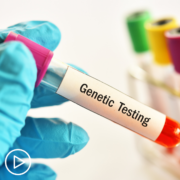Waldenström Macroglobulinemia Treatment Decisions: What’s Right for You? from Patient Empowerment Network on Vimeo.
What determines the best Waldenström macroglobulinemia treatment for YOU? In this 30-minute webinar, Dr. Jorge Castillo reviews key factors that affect treatment decisions, emerging treatment research, and shares tips for partnering with your healthcare team.
Dr. Jorge Castillo is Clinical Director at the Bing Center for Waldenström Macroglobulinemia Dana-Farber Cancer Institute and Assistant Professor of Medicine at Harvard Medical School. Learn more about Dr. Castillo, here.
See More From The Pro-Active Waldenström Macroglobulinemia Patient Toolkit
Download Guide
Related Programs:
Transcript:
Katherine:
Hello, and welcome. I’m Katherine Banwell, your host for today’s webinar. In this program, we’re going to help you learn more about Waldenstrom macroglobulinemia, what it is, and how it’s treated, and we’ll share tools to help you work with your healthcare team to access the best care.
Before we get into the discussion, please remember that this program is not a substitute for seeking medical advice. Please refer to your healthcare team about what might be best for you. Joining us today is Dr. Jorge Castillo. Dr. Castillo, welcome. Would you please introduce yourself?
Dr. Castillo:
Yes, hi. Thank you, Katherine. My name is Jorge Castillo. I’m the clinical director of the Waldenstrom’s Program at the Dana Farber Cancer Institute in Boston.
Katherine:
Excellent. Thank you for taking the time to join us today.
Dr. Castillo:
Happy to be here.
Katherine:
Before we get into the discussion, I’m sure this has been on the minds of many patients. Is the COVID vaccine safe and effective for Waldenstrom’s patients?
Dr. Castillo:
Yeah, that’s a great question. I think the short answer is yes. We have a number of studies that not only our center but other centers in the United States and Europe have been doing. And we have seen that patients with Waldenstrom’s do benefit from the administration of the COVID vaccine.
Katherine:
Excellent. Let’s start with the very basic. What is Waldenstrom macroglobulinemia?
Dr. Castillo:
Yeah, Waldenstrom’s macro – it’s a mouthful.
Katherine:
It is.
Dr. Castillo:
I can just call it WM for ease.
It is a blood cancer, and in this blood cancer, the malignant cells are nesting in the bone marrow. And not only that. These malignant cells kind of secrete, produce, a protein called IgM.
IgM is an antibody that should be protecting us from infections, and in a normal state, we all have a little bit of IgM, and that’s a good thing. But in these patients, with these malignant cells, as these cells accumulate in the marrow, they actually increase the levels of IgM in our patients, and that can translate into a number of different symptoms, which we will probably talk about later.
Katherine:
Yes. How is it staged?
Dr. Castillo:
So, the staging is a very interesting aspect. So, when we think about cancer, we think about stage I is in one spot, stage II in another spot, stage III, right, and it gets more extensive as we go along. That doesn’t really apply to Waldenstrom’s. Waldenstrom’s is a whole-body disease right from the start. The main reason for that is because it’s a disease of the bone marrow, and we all have bone marrow in all our bones, from our skull all the way to the great toe, so if you were to get a sample from each bone space, we would find the malignant cells there. So, this is a disease that is a whole-body disease right from the start, so therefore, there’s no stage I, II, or III. That is just the way we envision this.
Katherine:
How does the condition progress?
Dr. Castillo:
So, it’s interesting because a number of the patients that we see in my clinic are actually asymptomatic at the time of the presentation. I would say maybe about a third of the patients I see in my clinic that were diagnosed with this disease for other reasons. They either had an abnormal laboratory value or an abnormal imaging study or some other reason. And when they come, they are worked up. Initially, they are found to have these malignant cells and these IgM elevation, but they have no other problems whatsoever.
So, I would say most patients will be asymptomatic at the beginning of the disease, and probably they will be asymptomatic for years before the symptoms actually do start. So, what happens is the malignant cells start taking over the bone marrow space, and it reaches a point in which the bone marrow, the healthy bone marrow, doesn’t have space to produce the normal cells that they should produce.
So, the first things that we tend to see in these patients is anemia, so the hemoglobin level starts dropping.
The red cells are the first ones that are being affected by this process so that the anemia is being seen first. If we leave that for a long time, then the other blood cells will decrease also, the white blood cells and the platelets over time. But the first one is almost always the anemia. And obviously, that, patients feel tired. They feel short of breath. They feel fatigued and all of that.
Now, the IgM itself can cause other problems on their own. If they have there’s too much IgM, they can actually make the blood a little thick, and that can cause a little bit of problems with the circulation, specifically in the eyes, for example. Some patients have blurred vision. Some patients have nosebleeds or headaches, right, with all that hyperviscosity, which means the blood is too thick. In some other patients, we have nerve damage. You know, they can have numbness in their toes, and then that increases into the – progresses, extends into the feet, into the shins, into the knees and then the fingers.
And so, that happens over years sometimes. Some patients can have enlargement of lymph nodes in their necks and in the axillary areas or in the inguinal areas, or even enlargement of organs, the spleen and liver and things like that. So, when we think about the clinical manifestations of Waldenstrom’s, it varies, very diverse. But I would say most patients would have anemia. I think that’s probably the most important aspect of it.
Katherine:
Thank you for that. That’s really helpful. So, now that we know more about Waldenstrom’s and how it progresses, let’s turn to treatment. Help us understand when it’s time to treat. Certain patients, as you said, don’t really need treatment right away because they’re asymptomatic. So, which patient type should begin to get treatment?
Dr. Castillo:
That’s really the most important aspect of the discussion, I would say, because from my perspective – you know, I’ve been doing this for almost a decade, seeing probably 3,000, 4,000 patients with Waldenstrom’s in my career, I think one of the most important decisions is when to treat.
A number of our patients will be asymptomatic, and they will remain asymptomatic for years. So, really, treatment initiation in this scenario is not reasonable. Number one, we don’t cure the disease. Number two, patient have a long survival. I’m talking about 15, 20 years of survival in a large proportion of patients. So, a treatment that is going to last a year is not going to change a 20-year survival, so we don’t extend the survival of our patients in most cases.
Katherine:
Right. If a patient has been on watch and wait, how do you know when it’s time to begin therapy?
Dr. Castillo:
Yeah, so essentially, when we see patients in whom we decide to monitor, right, watch and wait, which is monitor them, we follow them over time, and we see them sometimes every three months or every six months, and we get bloodwork.
We do bloodwork on those patients to look at the hemoglobin, just to see if there’s anemia or not, to look at the IgM to see if it gets too high or not. And if the IgM is too high, sometimes, we’ll have the patients have eye examinations on a yearly basis to make sure that there’s no changes in the vessels in the back of their eyes, in their retinas. That’s an indication of hyperviscosity. And every time we see them, not only do we look at the numbers, which I think is important, but we also look at the symptoms.
So, I classically ask my patients, “How’s your energy level, how well you’re doing, still able to do everything you want to do? Any numbness in your feet? Right? Any nosebleeds, any headaches, any blurred vision, right? Any lumps? So, I just go over this list of different symptoms that patients can experience. Are you having fevers? Are you having night sweats? Are you losing weight for no reason? Right? So, it’s a monitoring process.
Just to clarify further, for example, a patient can come to see me with anemia, and I know that Waldenstrom’s causes anemia, as I said before. But it is my duty as a doctor to make sure that there’s no other reason why the patient might be anemic. So, even though in the scenario, which is very likely that the disease is causing this problem, I still need to make sure that it is not something else driving this anemia for the patient, and then the anemia is severe enough. You know, some patients say, “Yeah, I’m a little tired, but I’m still able to do everything I want to do.”
So, really that’s a very minor process. And there are people who tell me, “You know what, I cannot play with my children anymore, right, because I’m so tired,” then that’s a different process. So, the severity of the symptom and how related to the disease it is, that combination is what really tells us who needs to be treated or not.
So, what I would say in terms of treatment timing for Waldenstrom’s patients, it’s not that you need treatment and then you don’t need it, and then you need it. It’s not like that. It’s more like you don’t need it; you don’t need it; and then it is reasonable to treat. And there is a period in which it’s reasonable to treat, and that period can last sometimes months to years. Some patients can decide to be treated a little earlier in the process with less symptoms. And some patients can decide to be treated a little bit later with more symptoms.
So, it has to do a lot with the patients, how they feel, how they’re tolerating the symptoms, how dangerous or potentially threatening those symptoms are. And that’s a conversation that it needs to take place between the doctor and the patient, understanding the patient’s preferences.
Katherine:
Yeah. Yeah. What are the treatment goals for Waldenstrom’s?
Dr. Castillo:
So, as I said earlier, we don’t cure patients with Waldenstrom’s. Patients live with Waldenstrom’s, and I said before as well, for many years.
So, I think the goal of the treatment is to get back the patient – to get the patient back to how they were feeling before they became symptomatic. If the patient is not able to play with their children, as I said before, getting them back to play with their children again and have that energy. Or if they’re having all these lumps popping up in their bodies, kind of reduce the size of those lumps. Or if they’re having the neuropathy, have an improvement on the nerve ending damage and the numbness that they’re experiencing. If they’re having nosebleeds and headaches, resolve those symptoms.
So, in many other cancers, we think about complete remissions, cures, and that’s what we need to do. And we need to induce responses in our patients, and our treatments do induce responses in our patients, and responses are measured by IgM levels improvements and hemoglobin improvements and things like that, which is great to have the numbers improve, but I think it’s key to actually control the patient’s symptoms as well.
And I think it’s – from my perspective as a patient, if I were a patient, that would put it more important to me. So, what about my hemoglobin going from 10 to 13 if I’m not feeling better? So, I think feeling better is a very important aspect of what we do here.
Katherine:
Yeah, absolutely. Can you walk us through the currently available treatment approaches for WM?
Dr. Castillo:
Oh, there’s plenty. And that is actually a good message. So, there are many treatment options, and the treatment options are almost equally effective. So, I think we can separate the treatment options in big groups. I think that the big group, the first group that we use, treatments that are very effective, is chemotherapy-based. And we have a number of chemotherapy options that we use routinely for patients with Waldenstrom’s. We typically combine chemotherapy with an antibody called rituximab. And that rituximab is used universally for a lot of different blood cancers out there.
And so, when we combine the chemotherapy with the rituximab, I would say probably 90 to 95 percent of patients that get treated do feel better. Not only their numbers improve, but also the symptoms improve, the treatments. These treatments are typically given intravenously, and they are typically given for about six months of treatments. It’s very easy to tolerate.
I mean, it’s not the classic chemotherapy that we think about with other cancers, right? Losing your hair and vomiting and being very sick. That is not what happens with these chemos. They are very gentle chemos. But the fact that they are gentle doesn’t mean that they do not work. I mean, they are very effective against the disease, but they are more gentle in terms of the side effects. Some other side effects that I think are important with chemo specifically is the small risk of developing another bone marrow disease, and that’s because of how chemo works. It also damages a little bit the good cells, and that can cause other problems, and the risk of infections.
I think nowadays, in the context of the pandemic, I think the risk of infections is something that we need to really talk about a lot with our patients. But these typically are six-month treatments, intravenous treatments, and then done with treatments and very effective regimens. Then, we have the non-chemo treatments, which is you have a lot of those, development of those therapies over the years.
We do have a group of medications called proteasome inhibitors, or PIs. And we borrow those from the myeloma group.
Myeloma is another blood cancer that shares some similarities with Waldenstrom’s, so we use some of those treatments into our treatments. And these are non-chemotherapy agents. We also combine them with rituximab to make them more powerful.
And some of them are intravenous. Some of them are injected under the skin. Some of them are pills. And again, six months of treatments, very nicely tolerated, very effective. I’m talking about 90, 95 percent efficacy rate. And the side effects with this are more like nerve ending damage or more like lung, heart problems, not really secondary malignancies, but infections is also an issue here too.
And then, we have the most – the newer treatments that are the pill form treatment. We call them BTK inhibitors, B as in Boy, T as in Tom, K, BTK inhibitors.
We use that for many other diseases as well, but we use them for Waldenstrom’s too. And we use them alone in most scenarios. Sometimes, we can combine them with rituximab, but the large experience is without rituximab. So, it’s just the pill. Nothing else. No injections or infusions. No risk of secondary bone marrow disease. No risk of neuropathy. But they are pills that you have to take every day, indefinitely.
So, in contrast with the other six-month treatments, duration treatments, these are treatments that tend to last for several years. And we do have some taking these pills sometimes for six, seven, eight years, and they continue on them because they do well, and their response is as good as chemotherapy. But it’s just with a pill that you need to take every day.
Now, these pills have a different set of side effects, and that includes sometimes some irregular heartbeats, some bleeding and bruising. We have a new pill just that we published on recently, a medication called venetoclax, with a V. Again, it’s a different mechanism of action. It’s a BCL-2 inhibitor. It doesn’t have any risk of arrhythmia or bleeding, but it can cause some issues with infections.
But maybe you can take two years of this treatment and not take it indefinitely. So, all these are treatments that we keep advancing, and we will continue running studies with new medications that hopefully have similar or higher efficacy with a better side effect profile.
Now, just to finalize, the last option that should always be in the mind of a patient is clinical trials, investigational agents that are not sometimes – some of them are approved already by the FDA.
Sometimes they’re not. But they are agents that either in the laboratory or in prior experience suggest that they might have efficacy on these patients.
And that’s another treatment option that could be considered in some scenarios.
Katherine:
Okay, excellent. Efficacy and many factors coming into play, obviously, when making a treatment decision. How do you decide which treatment is appropriate for a particular patient?
Dr. Castillo:
Yeah, that’s a million-dollar question. And the reason that is the case is because when we think about other types of cancers, right, breast cancer and lung cancer, we do have these large studies with thousands of patients in which half of the group got one treatment; the other half got the other treatment. And we know that one treatment is better than other in this context of a randomized, large study. We don’t have a lot of that in Waldenstrom’s because it’s a rare disease. So, most of the studies that we do have are studies in which we have maybe 30, 40, 50 patients, 100 if we’re lucky, so comparisons between all these different treatments have not been done.
So, the chemotherapy, for example, versus the PI, there’s no study comparing that. The chemotherapy versus the BTK inhibitors, there’s no study comparing that. So, based on that, since there’s no comparison, we need to kind of understand the profile of the drug, you know. And you need to match that with the patient’s preferences.
So, we need to look at the patient’s age. We need to look at the patient’s comorbidities. We need to look at the patient’s medications that they’re on. Are their insurance going to cover the pills or not? Are they comfortable with getting intravenous infusions? What is the risk of leukemia versus the risk of neuropathy in those patients? So, we need to look at so many factors. Interestingly enough, efficacy is not the problem. We don’t choose treatments based on efficacy because all of the treatments are almost equally effective. We actually choose treatments based on patients’ preferences. We choose treatment based on the medication side effects.
And the newer thing is actually, we’re doing genomic profile in the patients. We’re actually seeing which mutations the patients have, and there are some treatments that work better or worse with specific mutations, so we kind of tailor a treatment option based on all those factors.
So, it’s not an easy job, but I think it’s rewarding to understand that the best treatment for a patient with Waldenstrom’s is a personalized treatment. And as long as –
Katherine:
That’s what it sounds like.
Dr. Castillo:
And as long as the patient understands the best he or she can in terms of the pros and cons of the treatment before going in, an educated decision, I think that’s probably best choice, yeah.
Katherine:
Are there test results that can impact options?
Dr. Castillo:
I would say so. So, for example, in patients who have very high IgM levels, we try to avoid giving rituximab alone, for example, because rituximab can also make the IgM go up in about 40 to 50 percent of the cases, and patients can become more symptomatic if they were symptomatic because of the IgM in the first place.
So, that’s one value that we follow carefully. Sometimes, the kidney function can tell us if there are some chemotherapies that cannot be given with a kidney function that is not normal or close to normal, for example. And again, there are some mutations that can help us understand if a treatment might work better than other treatments too.
So, yeah, there’s a lot of shades of gray in there to be able to pick and choose. And again, the patient’s symptoms are important. I mean, if a patient, for example, already has an arrhythmia, I’m going to try to avoid a medication that can cause more arrhythmias. If a patient has already some nerve damage, I’m less likely to recommend a treatment that can cause more nerve damage. So, yeah, there’s a lot of room there for personalization.
Katherine:
Yeah. You’ve mentioned existing conditions. So, how do patients’ specific factors like lifestyle and age and other preexisting conditions impact treatment choices?
Dr. Castillo:
Well, I think the way that affects it is just because patients who are older age tend to have other problems, you know. And I think having that in mind is important. So, if somebody has a liver dysfunction of some kind, then that will modify my treatment options. And as I said earlier, if someone has a kidney disfunction of some kind or depending on the degree, I can choose a different type of treatment there.
Now, also, we need to be mindful, for example, if somebody’s not so reliable on taking pills because they cannot remember or they don’t know, they are not organized enough or they don’t – you know. So, there are so many other factors playing into that role – maybe a pill form treatment might not be the best option, you know.
If somebody doesn’t have help to transfer him to take him to the infusion room back and forth, maybe an infusion treatment might not be the best there. So, again, another series of factors could be taken into account when making treatment decisions.
Katherine:
There’s obviously so much to consider when choosing therapy. What do you feel is the patient’s role in treatment decisions?
Dr. Castillo:
From my perspective, the patient’s role is very important. I need, as a physician, that the patient feels that it’s part of the team here. So, when patients come to see me, I strongly encourage patients to bring as many people as they want with them. If they want somebody on FaceTime at the same time, I’m happy with that too. And that helps because the amount of data that we provide, the amount of information that we provide, is a lot in terms of quantity. But sometimes, it’s not easy to understand when you just hear it one time, right?
So, having somebody taking notes, having somebody else taking notes, having somebody else listening, somebody else asking questions, and then somebody else explaining back to the patient – the patient is looking for the best for them, but if he’s also affected by the whole process. It would be naïve to feel – or to think – that somebody was told they have an incurable blood cancer, and they are completely paying attention to everything you’re saying, after you said something like that.
So, I think it’s important for patients to be there with family, friends, or whoever wants to be there to help out. I think that’s a really important aspect. Then, number two is you need to know about your own disease. And I am fortunate to work with a group of patients who are highly educated, to the point that they get to know more about their disease than their own doctor. And I think that’s key. I think that’s important. For me, that is not threatening or challenging. I think that is actually a good thing.
And that way, I can have a more direct conversation, meaningful, because I understand that the patient is understanding what I am saying, and we are trying to speak the same language, so I think that is key also. So, bottom line, I think education from the patient perspective, involvement of their care, I think that’s key so they can be their own best advocates.
There is going to be a lot of – since it’s a rare disease, there’s going to be a lot of backs and forths with different physicians. Some physicians are going to be more intensive and trying to treat when the patient doesn’t need to be treated. The opposite is also true in which a patient, they do need treatment, and the physicians are saying, “No, we can wait a little bit longer.” And again, that has nothing to do with the quality of the doctor. It’s just the fact that the disease is rare, and to keep up with it is very difficult. So, the patient being their best advocate is actually a very important role that they should have.
Katherine:
Knowledge is power.
Dr. Castillo:
That’s right.
Katherine:
How is treatment effectiveness monitored? How do you know if it’s working?
Dr. Castillo:
Yeah, so a couple of ways, right? We have the formal way and the informal way. So, the formal way to measure a response is, I mentioned before, the IgM. All right? So, the IgM levels, we use the IgM levels and how they decline over time on treatments to measure the response of the patients. So, based on the IgM decrease, we can actually classify the patients’ response in different depths.
So, we have minor responses, which is 25 to 50 percent decrease in the IgM, and then we have a partial response, which is a 50-90 percent decrease in the IgM, and then we have a very good partial response, which is a 90 percent decrease of the IgM or normalization of the IgM. So, it all depends. So, if your IgM let’s say, is 3,000, right, you will not be in a partial response unless your IgM is below 1,500, and you will not be on a very good response unless your IgM is below 300, for example. And that might be different for somebody who starts with an IgM of 10,000, and that might be different for somebody who start with an IgM of 500, right?
So, that’s the formal response criteria that we use, IgM-based. Having said that, we also have other factors in terms of the quality of life of the patient. So, we can see improvements in hemoglobin levels. We can actually see normalization of hemoglobin, even though the response to the IgM is minor. Right, you say “minor”, and I mean, how great that is?
But if the hemoglobin goes from 8 to 15 on a minor response, I think that patient is doing very well, right? So, we need to have those two hand-in-hand to understand what the benefit of the patient is seeing. If the patient is having hyperviscosity symptoms, for example, and the IgM was 6,000 and went down to 4,000, that’s enough for the patient to be without hyperviscosity symptoms. Then that’s a successful treatment too. So, we need to balance all that out and make sure that we understand it very well. So, yeah, we do have the formal IgM responses, but we do have the physical quality of life response that we should also pay attention to.
Katherine:
Fatigue seems to be very common among Waldenstrom’s patients. Here’s a question that we received before the program. Kasey asks, “Why do I feel so tired all the time? Is there anything that can be done about it?
Dr. Castillo:
That’s a great question, and as I said before and basically kind of summarizing what I put together, I mean, there are many patients why a symptom with Waldenstrom’s could be fatigued. One of them is they could be anemic. The other one, they could have some hyperviscosity symptoms causing some fatigue, maybe some inflammation in the body because of the Waldenstrom’s, but maybe there are other reasons why patients can be fatigued.
And if you go out there in the streets and you start asking people, “Are you tired?” 80 percent of Americans are going to be tired. I’m not trying to minimize the symptoms of the patients. What I’m trying to say is we need to be very careful at understanding what the relation of the fatigue is with the disease. We need to be convinced that there is a relation there.
If that happened in my clinic – for example, a patient comes to see me, and they are fatigued; their hemoglobin is 14, which is normal; their IgM is about 1,000, which is not supposed to cause hyperviscosity. So, I do not know really in that context if the Waldenstrom’s is driving the fatigue or not.
Katherine:
Or if it’s something else.
Dr. Castillo:
Exactly. So, we need to make sure that the patient doesn’t have any iron deficiency, that the patient doesn’t have any thyroid problems, that the testosterone problems are okay, that there’s no sleep disturbances, that there’s no depression. So, there’s so many different other things that we need to make sure are not there before we mount into that. Because if someone is fatigued with a hemoglobin of 8, which is very low, with my treatments, if I make that 8 14, I know the fatigue is going to get better. But if the patient is fatigued with a hemoglobin of 14, which I am not going to improve with my treatments, then how confident do I feel that I’m going to improve the patient’s quality of life with a potentially dangerous treatment?
So, we talked about already secondary leukemias, neuropathy, other problems that the patient can have with the treatments or because of the treatments.
So, we need to balance that out and understand that the potential benefit has to be higher than the potential risk, and that’s why the personalization comes into play. So, fatigue is a big issue, and we try to take a very systematic approach about that, you know, ruling out other conditions, making sure that we understand its relation with the disease before recommending treatment just for fatigue.
Katherine:
Yeah. This is one side effect that is so important for patients to share with their healthcare team, right?
Dr. Castillo:
Oh, absolutely.
Katherine:
So that their healthcare team can know how to treat them.
Dr. Castillo:
That’s right. And again, there are so many interventions that are not medications that could be done in these type of situations, right? Meditation, mindfulness. There are so many other approaches to try to help in these type of situations, changing a little bit sometimes the perspective, trying to be a little bit more on the positive thinking, right?
So, there are so many different ways outside of pharmacological approaches that we can use to try to improve our patients’ quality of life.
Katherine:
Yeah. Knowing that one has an incurable disease can be very stressful, right? Knowing that you have to live with this.
Dr. Castillo:
That’s absolutely correct, and again, what I’ve seen happening in some of my patients is every little thing that happens to them, they do not know if it’s because of the disease or not.
Katherine:
Oh, yeah.
Dr. Castillo:
“So, I have a twitch there. Oh, it’s due to Waldenstrom’s. Do I need to be treated because of that twitch?” And that, I understand it. Well, I try to understand it. I’m not in that same situation, so I cannot understand it completely. But I try to understand how if you don’t trust your body anymore, right? I mean, you have a disease, and you don’t trust your body anymore, then how you trust all these little symptoms here and there?
So, in my conversations with my patients, I discuss these things openly and that you’re going to have a lot of different symptoms here and there. Most of them probably are not going to be related to the disease, but if some of them are concerning enough to you in terms of your activities, in terms of eating, drinking, sleeping, social life, sexual life, you know, working life, then let me know, and then we will be happy to investigate those because anything can happen to anybody.
So, you can have other problems. Waldenstrom’s doesn’t protect you from anything, so, and it’s always important to discuss this with patients and pay attention to the patients, not dismiss their symptoms, think about them with them, talk about them with the patients to try to understand how these are affecting them.
Katherine:
Dr. Castillo, are there emerging approaches for treating Waldenstrom’s?
Dr. Castillo:
Always. And that’s the beauty – that’s the second part of when we talked about clinical trials, right, we talked about clinical trials? Science continues, and we work very closely with an organization called the International Waldenstrom’s Foundation, and they support research all over the world for Waldenstrom’s.
So, their message is since the sun comes up until the sun comes down, there is someone, somewhere in the world working on Waldenstrom’s, and that’s true.
So, there’s a lot of science in the background, and that science helps us understand how the Waldenstrom’s cells behave, and therefore, we can then start targeting some things. That’s how BTK inhibitors came out. That’s how proteasome inhibitors came out. That’s how BCL-2 inhibitors came out. All these are the result of science, applied into the treatments. So, at my institution and many other institutions in the country and outside of the country, there are newer treatments being tried all the time.
We have now – we are looking into combining BTK inhibitors with other agents. Germany is doing a number of different studies. Canada is doing a number of different studies. We are doing some studies in the United States as well, combining chemotherapy and PIs with the BTK inhibitors. We’re doing a study in my institution combining BTK inhibitors with BCL-2 inhibitors. So, and the idea is to try to create a more powerful agent or regimen and hopefully maybe not give patients indefinite treatments, more like fixed duration treatments.
So, I think that’s where it’s coming. It’s coming maybe double, triple combinations, fixed duration treatments. That’s what is coming in terms of that aspect of the research. And then, we do have newer compounds coming out.
We do have now some concepts in what we call immunotherapy, right? We think about antibodies.
We think about bispecific T-cell engagers. CAR-T cells, so all that is actually up and coming in Waldenstrom’s. There are actual clinical trials being done today evaluating all those different treatments for patients with Waldenstrom’s.
So, I think the future is really bright. I’m really optimistic, to be honest with you about the treatment of patients with Waldenstrom’s. Obviously, what we need, what we want, is cure of the disease. And again, we can think about cure in two different ways. We can think about the classic definition of cure in which we treat patients, the disease goes away, you stop treatments, and the disease never comes back, right? That’s one way of looking at cure.
The other way of looking at cure is you treat the disease, the disease is in a remission, you continue treating the patient, and then the patient basically dies of other reasons, right? That is a functional cure. So, I think we’re closer to the latter, much more than the former, but the efforts to continue developing new treatments, it’s not stopping anytime soon.
Katherine:
No, because we’re always constantly moving forward, having to find new treatments, definitely. Well, Dr. Castillo, thank you so much for taking the time to join us today.
Dr. Castillo:
It has been my pleasure. I mean, I always enjoy the opportunity to be able to communicate with patients about what I love doing.
Katherine:
Yeah. Thank you, and again, thank you to all of our partners.
To learn more about Waldenstrom macroglobulinemia and to access tools to help you become a proactive patient, visit powerfulpatients.org. I’m Katherine Banwell. Thanks for being with us today.





















